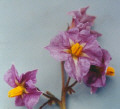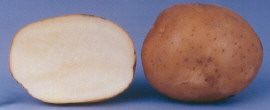PDF (35 kb)
Pictures - PDF (221 kb)
Click on Image for Larger View
General
- Origin & Breeding: bred by Caithness Potato Breeder Ltd. from the cross (143-27 (ex. Solanum Vernei) x Cara) in Scotland in 1982.
- Year registered in Canada: 2010
- Registration number: 6765
- Maturity: late
Botanical Features
- Plants: tall, semi-erect, bushy; many pigmented thick stems; prominent single waved wings; slightly swollen nodes, slightly pigmented.
- Leaves: semi-open, long, arching, bluish-green, glossy; petioles and top of midribs moderately pigmented; petiolules distinctly pigmented in axils.
Terminal leaflets: narrowly ovate; overlapped; tip acute; base obtuse and slightly asymmetrical; strongly wavy margins.
Primary leaflets: narrowly ovate; tip acute; base cordate, slightly asymmetrical; strongly wavy margins.
Secondary leaflets: numerous; many on petiolules of lateral leaflets; usually one pair (small) on petiolule of terminal leaflets. - Flowers: strongly pigmented red-violet corolla; star slightly prominent, long flower stalk; calyxes, peduncles and buds strongly pigmented; orange anthers.
- Tubers: round to oval; smooth buff coloured skin; few medium-shallow eyes, predominantly apical; cream coloured flesh.
- Sprouts: spherical, blue-violet, weakly pubescent; base strongly pigmented; tip weakly pigmented, closed habit.
Agricultural Features
Very high yielding variety; tubers with good appearance. Numerous tubers per plant; high percentage of large tubers. It is recommended to use a spacing of 30 cm (12 in) on the row. Good resistance to internal and external defects; can stand adverse conditions like cold spring or drought. Tolerant to heat stress.
Argos needs a long vegetation period to produce high yield; it needs less nitrogen than other varieties. It is recommended to use 80 to 120 kg/ha of nitrogen depending of the soil's fertility. Low dry matter. Good storability, long dormancy period.
- Utilization: mealy texture, none to trace after cooking blackening; good for boiling, fair for baking.
- Chief Market: fresh market
Reaction to Diseases
Field immune: potato wart.
Resistant: golden nematode (Globodera rostochiensis pathotype Ro1).
Moderately resistant: pale cyst nematode (Globodera pallida pathotype Pa2/3), tuber late blight, common scab, black leg, PVX.
Susceptible: gangrene, PVY, leaf roll, late blight on foliage.
References: é 1, 3, 4.
Send your comments to cfia.potatosection-sectiondespommesdeterre.acia@inspection.gc.ca regarding potato variety descriptions.




